I’ve talked with Chinese hams during some of my overseas postings — as 7J6CBQ in Okinawa, Japan and as 7Q7DFC in Lilongwe, Malawi — though not yet from my home station in Virginia. During my ten years working as a US diplomat in the PRC I wasn’t able to get a ham license but did follow ham radio some in the pages of the Chinese electronics/radio magazine Wuxiandian (無綫電 Wireless) which had articles about amateur radio from time to time.
Perhaps some day soon Russian cosmonaut-hams and US astronaut hams on the International Space Station will be talking with Chinese taikonaut-hams (huotui 火腿)in their Palace of the Heavens 天宮 Tiangong space station and with many radio amateurs on Earth. The Dream Sky Experiment Module of the Tiangong Space Station includes plans for amateur radio communication.
Amateur radio payload
CSSARC is an amateur radio payload for the Chinese space station, proposed by the Amateur Radio Section of the Radio Association of China (CRAC), the Shanghai Institute of Aerospace Systems Engineering (ASES) and Harbin Institute of Technology (HIT) [21]. The first phase of the payload is capable of providing the following functions using the very high frequency (VHF)/ultra high frequency (UHF) amateur radio bands:
- V/V or U/U crewmember voice;
- V/U or U/V FM repeater transponder;
- V/V or U/U 1k2 AFSK repeater digits;
- V/V or U/U SSTV or digital images.
The payload will provide a resource for radio amateurs around the world to contact or communicate with each other and the astronauts on board. It will also serve to motivate students to pursue interests and careers in science, technology, engineering and mathematics and to encourage more people to take an interest in amateur radio.
From Chinese language Wikipedia article 梦天实验舱 the (via Google Translate) Dream Sky Module of the Tiangong Space Station
On this translation blog I translated part of an online Chinese science fiction novel 2021: Chinese SF/Ham Radio Web Novel: We Live in Nanjing in which ham radio plays a prominent part. This novel, by Tianrui Shuofu, in November 2021 won the Science Fiction Galaxy Award for best online science fiction novel.
First appeared in Electronic Circuit Development Study
by Wang Zhao 王超
公众号:电子电路开发学习,id:mcu149

A group that accounts for only 1/10,000 of the country’s population – amateur radio enthusiasts
Amateur radio enthusiasts, a group that makes up only one-tenth of one percent of China’s population.
On the last day of 2022, I received a radio station license from the Beijing Radio Association, remembering that I had applied for it in October, and it had been more than two months since then, and without the courier boy’s call, I would have forgotten about it.

For amateur radio, probably 99% of you don’t know what it is? What can you do with it? How do you get an operator’s license and radio station license? What call sign do you get?
In this post, I’ve compiled some content to share with you, as well as documenting the process of applying for my radio station operator’s license and radio station license.
What’s it all about?
- 1. The never-fading airwaves – what is amateur radio?
- 2. Qualifications for “playing” Amateur Radio: operating certificates and licenses
- 3. The world-wide unique identifier of a radio station identity card – call sign
- 4. How to call CQ
- 5. What do radio enthusiasts do?
- 6. Exclusive festival for radio enthusiasts – 55th Ham Radio Festival
- 7. Cards exchanged among radio amateurs – QSL cards
- 8. Guidelines for amateur radio amateurs
- 9. Study materials
- 10. Summary
I hope that reading this article will give you a little bit of knowledge and understanding of Amateur Radio, the circle of Amateur Radio enthusiasts.
1. The never-extinguished radio waves – what is amateur radio?
Amateur radio belongs to a branch of radio, as officially explained by the Amateur Radio Section of the China Radio Amateur Club China Radio Association:
“Amateur radio” generally refers to the amateur affairs of radio, i.e., radio communication operations for self-training, mutual communication and technical research by amateur radio enthusiasts.
Note that the word “amateur” in “amateur radio” does not correspond to “professional radio”, nor is there such a term, where “amateur” refers to amateur operations that can be interpreted as non-professional that is in contrast with non-amateur, professional radio operations used in aerospace, marine vessels, railroad transportation, broadcasting and communications, and other sectors.
The Property Law of the PRC 物權法 stipulates that radio spectrum resources are owned by the State and are limited natural resources, and that the use of radio spectrum resources requires a radio frequency use license.
No one can use radio frequencies illegally, even with a legal amateur radio operator’s license and station license, beyond the frequency range delineated for amateur operations.
Amateur radio is a very common hobby around the world, and those who enjoy it are also known as amateur radio enthusiasts also known as hams. Hams are made up of the names of the three founders of radio, and those who are interested in amateur radio but do not have a call sign are called “sausages”. [香肠 maybe a Chinese expression, I haven’t heard of it in the US.]
[Translator’s Note: There are several fun stories about the origin of “ham” meaning radio amateur. None are convincing. Perhaps it started as a derisive term by professionals about non-professional radio operators — in the late 19th century US a ‘ham’ was an inexpert actor, although subsequently the meaning evolved towards very or overly dramatic actor — say like Captain Kirk/William Shatner in Star Trek! In the spark radio days, radios had little or no selectivity so everyone interfered with one another. End note]
People who want a amateur radio license must learn about the subject and pass a test from their country’s administration to receive an amateur radio operator’s license. There are about 6 million registered amateur radio enthusiasts worldwide.
As of 2022, according to unofficial statistics, there are about 190,000 registered amateur radio enthusiasts in China, ranking No. 3 in the world. The USA is in the top spot at about 800,000, followed by Japan at about 400,000 radio amateurs.

So in terms of population base, our amateur radio enthusiasts make up about one ten thousandth of China’s population.
Below are the emblems of the International Amateur Radio Union (IARU) and the Amateur Radio Section of the Chinese Radio Association (CRAC).
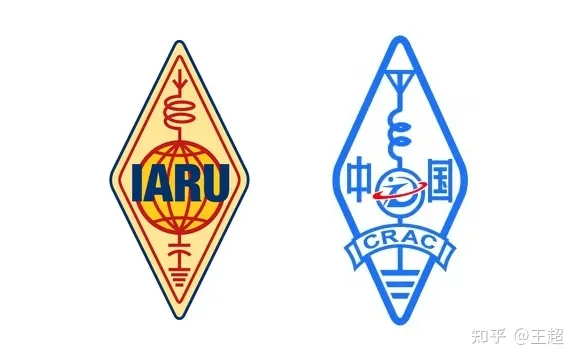
The development of amateur radio in China came late compared to other countries. There were only a few hams as can be seen from the relatively few people who took the license examination each year.
Just past December 22, 2022, is the 30th anniversary of the restoration and opening of China’s individual amateur radio activities. On that day in 1992, China’s first batch of old amateur radio enthusiasts, after an interruption of more than 40 years, were for the first time permitted to get on the air from their personal amateur radio stations. Since amateur radio stations have been sprouting up in the prelude to a dramatic rise in their numbers.
2. Qualifications for “playing” amateur radio: amateur radio operator’s license and radio station license.
Radio spectrum resources are owned by the state and are limited natural resources, and the use of radio spectrum resources requires a radio frequency use license. –Property Law
Some friends may ask, that I usually often use the walkie-talkie need a license? The law provides that public walkie-talkies with a transmitter power of not more than 0.5W and wireless walkie-talkies operating on designated frequencies can be used without a license. However, if you want to use a walkie-talkie with a transmitter power of more than 0.5W and join the ranks of amateur radio enthusiasts, you need to be licensed by the national radio administration.
There are two documents for licensing:
- China Radio Association Amateur Radio Operator’s Certificate (referred to as Operator’s Certificate)
- Radio station license of the People’s Republic of China (referred to as radio station license)
With these two licenses, one is considered a true amateur radio HAM and can legally use an amateur radio station.
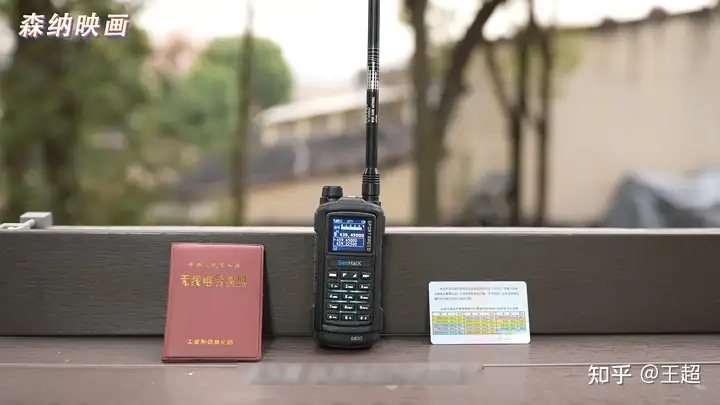
An operator’s license can be likened to a driver’s license for a motor vehicle, which shows that you have the ability to operate a radio station, while a license can be likened to a driver’s license for a car, which shows that you have set up a legal radio station.
The amateur radio operator’s license is a card the same size as an ID card, and can be divided into three categories, ABC, with different frequency ranges and transmission powers available for different categories:
- The Class A operator’s license is blue in color and can be used for transmitting work in all amateur and satellite amateur business bands in the range of 30 MHz to 3000 MHz, and the maximum transmitting power is not more than 25 watts.
- The Class B operator’s license is green in color and can be used for transmitting work in all amateur business and satellite amateur business bands, with a maximum transmitting power of no more than 100 watts in the bands below 30 MHz, and no more than 25 watts in the bands above 30 MHz.
- The Class C operator’s license is red in color, and can be used for transmitting work in all amateur business and satellite amateur business bands, with a maximum transmitting power of no more than 1,000 watts in the bands below 30 MHz, and no more than 25 watts in the bands above 30 MHz.

Simply look, B and C class operators can operate short wave radio bands below 30MHz where they can make long distance contacts using sky wave and ground wave, short wave signal from the station antenna are reflected back to the ground by the ionosphere, and by the ground reflected back to the ionosphere. This can happen many times, and thus radio signals can propagate a long ways ( hundreds to tens of thousands of kilometers ) . You can connect to the world! This is not a dream!
The available frequency range of the operator’s license can be seen described on the back of the license.

A radio license is obtained by applying to the local radio authority with a radio station with an approved code after obtaining an operator’s license.
The top of the license includes information such as the name of the person who set up the station, the ID number, the address of the station, the type of station, the call sign of the station, and the model number of the station.
Radio license pattern
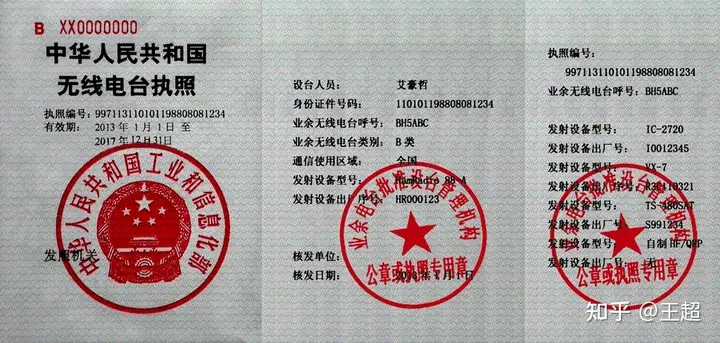
A radio license is valid for five years, and when it expires, you need to apply for renewal at the issuing agency one month before the expiration date.
The two documents, the operator’s license and the radio license, are required to legally use an amateur radio station.
There is no age limit to apply for the operator’s license exam, but applicants for a radio license need to be at least 18 years old, which means that if a child in the family gets his or her operator’s license and the parent has a radio license, then the child can use the parent’s radio station and call sign when they get on the air.

After the introduction of these two certificates, the following is an example of how to obtain these two certificates by registering for the amateur radio examination and applying for a radio station license in Beijing, which can be referred to by other provinces and cities in the country.
Register for the exam
The first step is to register, you need to get the examination information first, you can check the examination notice issued by each local association, if you can’t find it, you can go to the official website of Amateur Radio Branch of China Radio Association to check the examination information: http://www.crac.org.cn/.
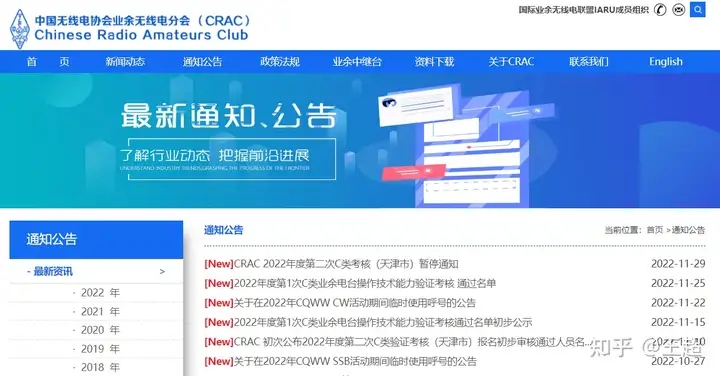
You can also check the exam information in the Smart Spectrum App. In Beijing, it is released through the official website and public number of the Beijing Radio Association, usually with a month’s notice.
Beijing Radio Association official website: http: //www.bjwxdxh.org.cn/, public number: Beijing Radio Association.
AB exams are generally organized once a month, but in recent years, due to the epidemic, the frequency of organization is also lower, it is estimated that 2023 will be more, C due to the number of applicants is small, generally one year to organize an exam.
It should be noted that: apply for the class A test without any restrictions; apply for the class B test, you need to pass the class A test 6 months before enrolling; apply for the class C test, you need to obtain the class B operator’s license and set up the station for 2 years before enrolling.
The number of applicants for each exam is limited. After finding the registration information, use your computer to log into the official website of the Beijing Radio Association and go to the registration page, if you don’t have an account, you need to register first.
http://xt.bjwxdxh.org.cn/loginmember/

Once you have successfully logged in, there will be a long image on how to fill out the enrollment information.
More information in this chart on how to apply to take the amateur radio examination in China (in Chinese).
Exam registration fees vary from province to city, Beijing side is no charge, you can also choose to pay 100 yuan membership fee, there will be more than 1 hour of training time before the exam, other areas can check the local exam registration information.
I am choosing this exam on September 3, 2022, after registration will review the registration information, about a week, will be posted in the public information of the final successful applicants, watch out for the examination room and the time of the examination.
Getting Ready
After successful registration, you can start to prepare to brush the question bank, and do not have to be too early, 2 to 3 days before the examination to brush a few times on the line, recommend the following micro-channel small program developed by HAM:
- Question Bank Practice Applet: Amateur Radio Toolset developed by BD7KZS
- Question bank practice applet: HAM practice exam developed by BI6LAL, BG1DX, BA1AJ
You can also download the latest question bank of ABC category from the official website of the association, the question bank is occasionally updated, the latest version of the ABC category exam question bank is 20211022 version.
Online practice exam website: http://kaoshi.wuxiandian.org.cn/ Via Google Translate to English, the link is https://kaoshi-wuxiandian-org-cn.translate.goog/?_x_tr_sch=http&_x_tr_sl=auto&_x_tr_tl=en&_x_tr_hl=en-US&_x_tr_pto=wapp

For the enthusiasts who have just started, to start from the Class A certificate, focusing on amateur radio laws and regulations and basic knowledge of the test, Class B and Class C ability to verify the more focused on the actual operation of the through the link as well as the theoretical knowledge of the radio.
- The Class A Operational Technical Competency Verification is a 30-question test, with 25 correct answers to pass, and a 60-minute exam with a 365-question question bank.
- The Class B Operational Technical Competency Verification is a 50-question test, with 40 correct answers to pass, and a 90-minute exam with a 689-question question bank.
- The Class C Operational Technical Competency Verification is an 80-question test, with 60 correct answers to pass, and a 150-minute test with a total of 1,066 questions.
All ABC exam questions are single-choice, and the ABC question pool overlaps by about 200 questions.
Exams
In Beijing, if you pay the membership fee of the association, you can attend a training before the exam, which is about 1 1/2 hours, just to introduce the knowledge of Amateur Radio, and it is still very useful!
After the training will start the test, the test process can not use the phone, closed book form, different places, some are paper rolls, some are on the machine test, some are on the scene with a cell phone to answer questions online. The questions are generally relatively simple, if you brush up in advance, it is very simple to pass, I think it is a lot simpler than the driver’s license exam.
About a week after the exam, the organizer will announce the list of those who have passed the exam. After passing the exam, you can choose to receive your operator’s license on-site or send it by courier.
Operator’s license is an ID-sized card with different colors for different classes, with name, ID number, operator’s license number, Class A starts with A, date of issuance, place of issuance and other information.

Applying for a license
Once you get your operator’s license, you can legally operate an amateur radio station, and if a close friend has a legal radio station, you can use his station and call sign to transmit.
If you also want to apply for a globally unique call sign, you can be prepared to purchase a radio station to use and apply for a license.
If you are taking a Class A operator’s license, it is recommended that you choose a station with a UHF/VHF bands and less than 20W of transmitter power, and if you have Class BC certificate you can choose to set up a shortwave transmitting station.
In order to successfully apply for a license, we must purchase a model with the CMIIT ID type approval code of the Ministry of Industry and Information Technology, and the official website of Beijing Amateur Radio Association has a list of models that can pass inspection.
http://www.bjwxdxh.org.cn/news/upload/20221011/1665455157.xls
There are many models inside, shortwave radios, UV band hand stations, car stations are available, brands imported, domestic are available, the price ranges from within a hundred dollars to tens of thousands of dollars, the function is also different, according to their own needs to choose. You can check the model and expiration date corresponding to the approval code at the following URL:
https://cmiitid.cn/
Below is the approval code information for the Baofeng UV-5R handpiece.

Beginners can choose a generation of Baofeng UV-5R first generation, the price is less than a hundred RMB. This radios functions are also very complete, there are still the second generation to the ninth generation of products, but try to buy the first generation of products, because the other later generation models may not be able to pass the inspection of the machine.
The classic model Baofeng UV-5R, is said to be the hand-held radio that Russian soldiers are now equipped with.

Made in Japan YAESU Hand-held

Common radio brands are: Motorola Motorola, Quansheng Quan Sheng, ICOM Aikomu, YAESU Yaesu, OUXUN, Hytera Hai Nengda, Baofeng, BORISTONE(堡利斯通), Xiaomi, 森海克斯(SenHaiX), and so on, the price is from less than a hundred RMB, to tens of thousands of RMB. I bought the 森海克斯(SenHaiX)8600 this 5W handheld table, a multi price 260 RMB. It has an LCD color screen, Chinese menu, USB charging, aviation frequency.
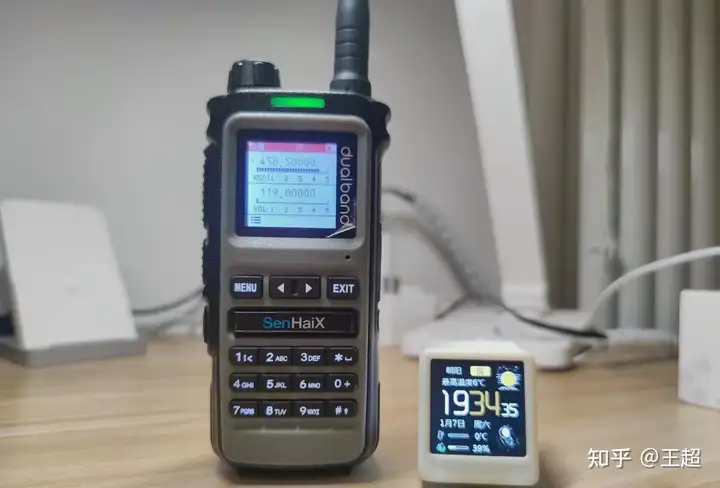
After you buy your radio, you can take it to the local amateur radio association or management body to apply for a license, different areas need different materials, Beijing side only need to bring the radio and ID card, registration of identity information and radio model, factory serial number can be, the whole process is very fast.
Of course, for the more technically-minded hams can build their own radio. For homemade equipment, you need to first go to the designated agency for testing, such as transmitting frequency range, power, stray emissions and so on the indicators for testing before they can be used to apply for a license.
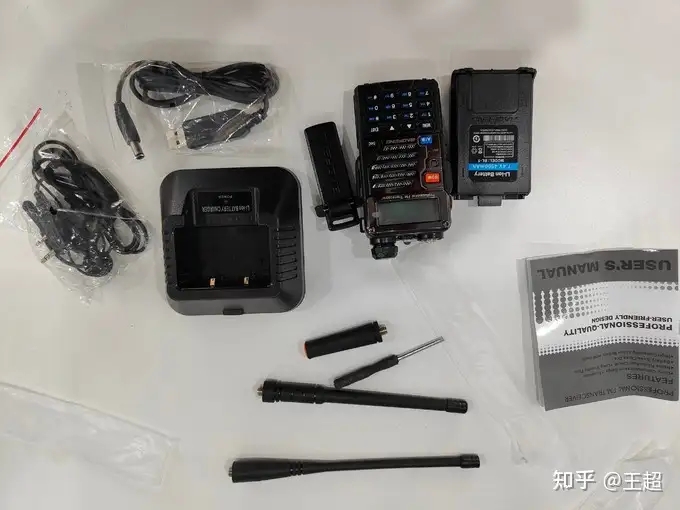
The time for license issuance varies from place to place, usually one and a half months in Beijing. During the waiting period for license, you can first join to the local QQ or WeChat exchange group, and keep listening on the commonly used frequency (438.500 MHz), to see what other HAMs are chatting about, how to start and how to end, and don’t transmit until you get the license!
My radio station license (BI1OCO):
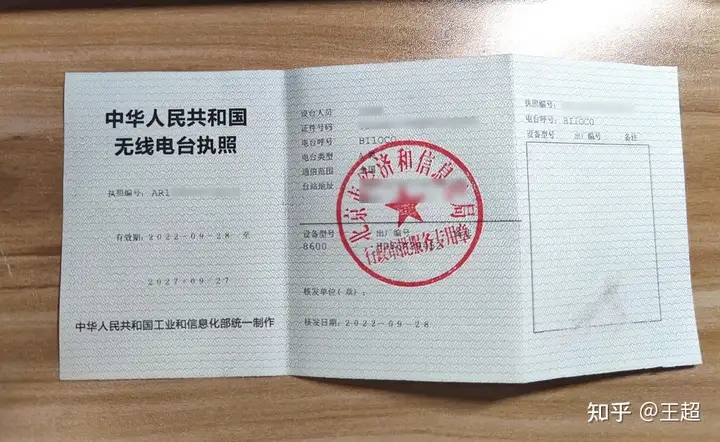
3. A globally unique radio identity card – the radio call sign
A radio call sign is a string of characters consisting of Latin letters and numbers used to identify the radio station that is communicating.
The call sign is an amateur radio identification that is unique worldwide and is a source of honor for amateurs.
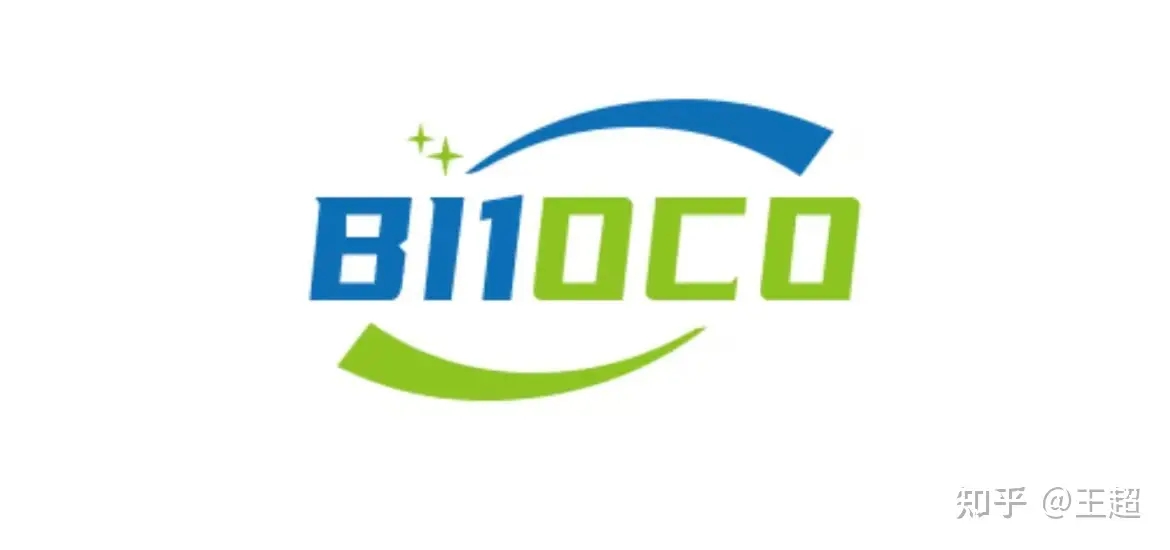
The call sign belongs to the radio station, and because of its uniqueness, the call sign also stands in for a particular person when communicating.
Some celebrity callouts:
- “Mahatma” Gandhi, call sign UA1LO. [Note: A Russian call sign. Some claim that the first man in space Yuri Gagarin held the amateur call UA1LO although there is no reliable evidence for that story.]
- Sony founder Akio Morita, call sign JP1DPJ.
- Nobel Laureate Prof. Martin Ryle, call sign G3CY
Zhou Haiying 周海嬰, the son of Lu Xun, was a keen amateur radio enthusiast as a child, and in 1952 he was admitted to the Radio Department of the Physics Faculty of Peking University, where his call sign was BA1CY.

Mr. Tong Xiuyong, call sign BA1AA, is one of the authors of the book “Amateur Radio Communications”, which is a must-read book for beginners, and has contributed to the development of amateur radio in China for a long time.
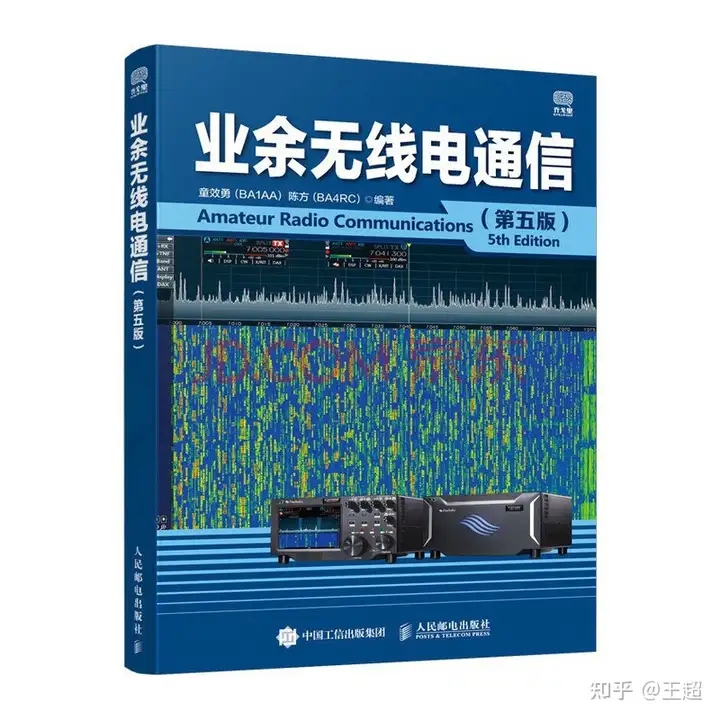
Amateur radio call signs generally consist of: 2 letters + 1 number + 1/2 letter.
There are about 40 prefixes for Chinese call signs, but only 10 are actually used, with only 5 being the most common.
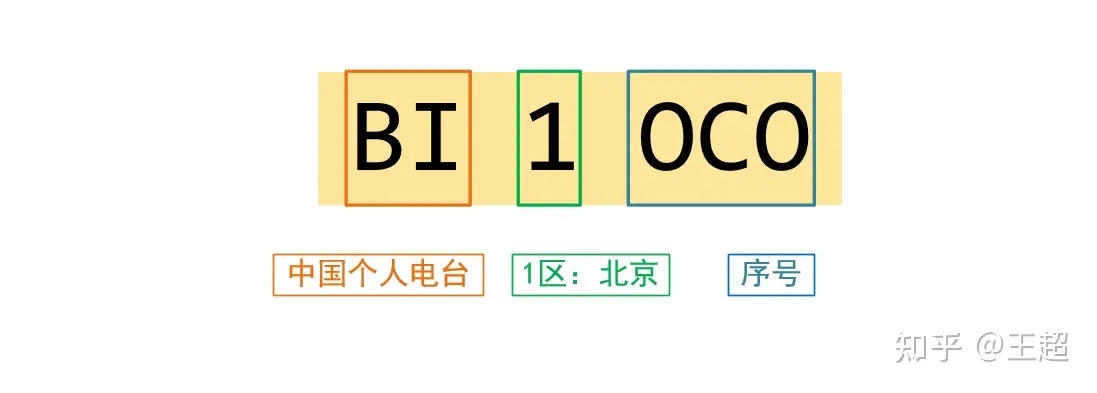
Let’s introduce the call sign BI1OCO as an example, we first divide BI1OCO into three parts, BI-1-OCO.
① The first part is the prefix, where BA, BD, BG, BH, BI denote individual stations, BY denotes group stations, and BR denotes amateur repeaters.
② The second part is also a prefix to indicate the region where the radio station is located. Amateur radio stations in China are divided into ten zones, of which Beijing is zone 1.
(iii) The third part is a suffix, which is used to distinguish between different radio stations.
Our amateur radio call sign partition:
- Area 1: Beijing and amateur satellite communications;
- Zone 2: Heilongjiang, Liaoning, Jilin;
- Zone 3: Tianjin, Hebei, Inner Mongolia, Shanxi;
- Zone 4: Jiangsu, Shanghai, Shandong;
- Zone 5: Zhejiang, Jiangxi, Fujian;
- Zone 6: Henan, Anhui, Hubei;
- Zone 7: Hunan, Guangdong, Guangxi, Hainan;
- Zone 8: Chongqing, Sichuan, Guizhou, Yunnan;
- Region 9: Shaanxi, Gansu, Ningxia, Qinghai;
- Zone 0: Xinjiang, Tibet;
Outside of mainland China, the most common prefix for Taiwan callsigns is BV, e.g., BV2AC; Hong Kong callsigns are prefixed with VR, e.g., VR2UNA; and Macao callsigns are prefixed with XX, e.g., XX9AU.When you see callsigns beginning with BA to BZ, you can conclude that they are Chinese callsigns.
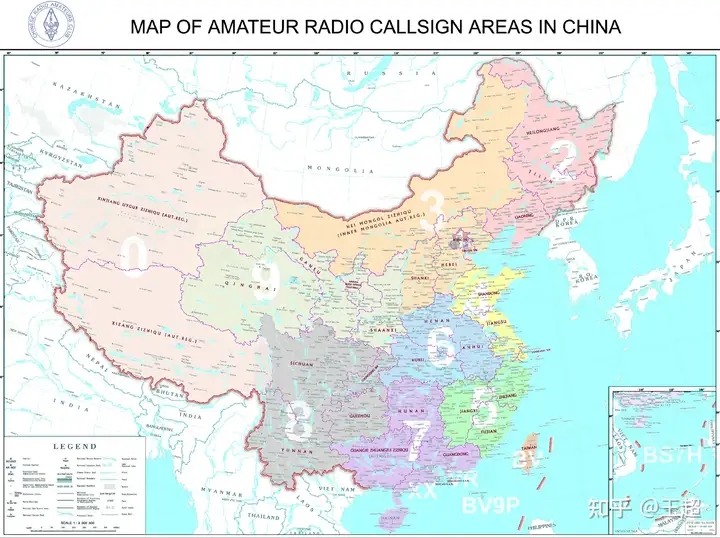
4. How to call CQ
CQ is a broad call to a station on the current frequency, meaning “seek you” [Translator’s Note: see Wikipedia article CQ (call) End note], and standardized CQ calling and answering is a fundamental skill for a HAM.
The following is an example of BI1OCO initiating a CQ call and BH1ZZZ responding.
BI1OCO: CQ, CQ, CQ! This is BI1OCO, Bravo India One Oscar Charlie Oscar calling a station on the frequency, please respond if you receive, Over!
There are also often location-specific calls in shortwave comms. For example, “CQ NA CQ NA CQ NA, this is BI4XXX, calling CQ and standing by”. This is when BI4XXX is making a designated call to a NA (North American) station, and stations in other locations should not answer his call.
If a station receives this call, it will reply:
BI1OCO, this is BH1ZZZ, your signal 59!
BI1OCO will answer if it receives a reply from BH1ZZZ:
BH1ZZZ, copied, and your signal to my side is 59.
Ending the exchange, so to speak:
Thanks for the signal report, 73!
The 59 here indicates an RST report with a strong signal and a clear voice, to prompt the other party according to the actual signal quality, and the 73 at the end of the pass-through indicates goodbye and sends good wishes.
In addition to this, the QTH (location) of one’s station and the type of station used, antenna, etc. will be reported, and one radio amateur might ask about other party’s location and equipment will be asked to determine the distance and transmitter power used and so forth.

The English words used in the above communications, such as Bravo India Oscar Charlie, are amateur radio phonetics for letters of the alphabet. They are widely used in amateur radio communications.
Because of the low output power of amateur radio, the received voice signal distortion or fading phenomenon is serious, affecting the analysis and identification, the call is prone to many mishearing errors. Especially mistakes in distinguishing B from P, D from T, G from J, M, N, R and I and other words are most likely to be misheard.
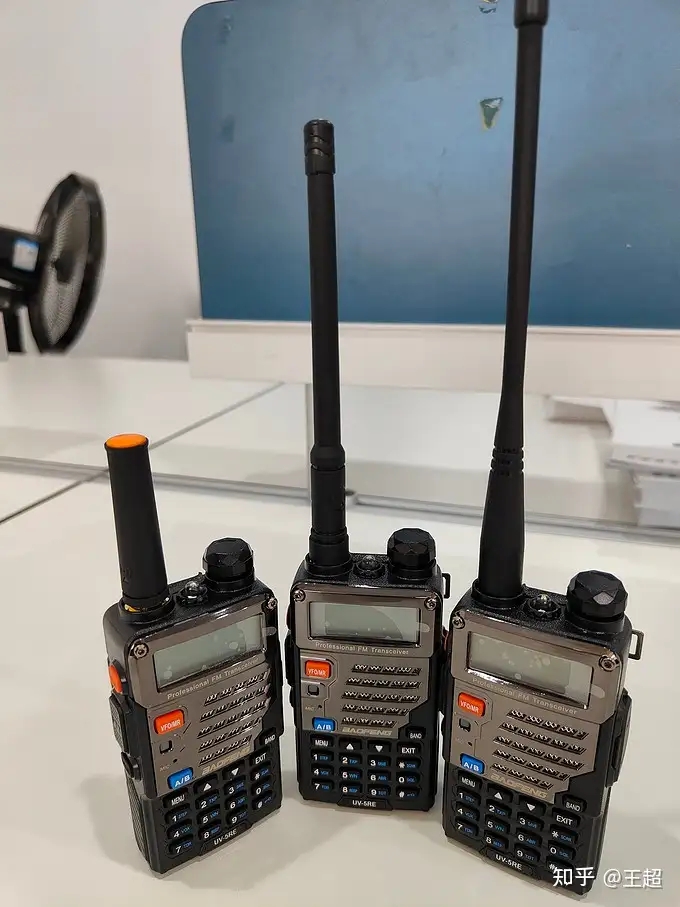
In order to avoid this problem, the world’s radio stations in the voice communication are used in the alphabet interpretation method, the general radio station in talking about the call sign, name or QTH (radio station location) when the use of this method of interpretation, in order to avoid misunderstandings. Such as “A” read Alpha, “C” read Charlie, “R” read Romeo, “J” read Juliet and other 26 letters of the alphabet are commonly used interpretation.

In addition to the alphabetic method of interpretation, Q-simplified is a three-letter communication abbreviation used worldwide, e.g., QRA your station name?QRF where are you from?QRZ who is calling me?
5. What do radio enthusiasts do in their hobby?
Amateur radio activities include a very wide range of contents, such as communication practice to improve operating skills, various research experiments for the purpose of scientific research and innovation, various engineering productions for the purpose of self-reliance in developing equipment and improving hands-on ability, and friendly exchanges between enthusiasts from different countries with frequent exchanges of personnel and letters, etc.
The fundamentals required for these activities, such as electronics, physics, communications, computer technology, foreign languages, geographic knowledge, and even the character qualities of the individual hobbyist, in turn motivate the hobbyist to devote himself to more study and improvement.

①Voice communication
Using amateur radio to talk on the air to exchange personal information and report to each other on signal quality and equipment is an introductory activity for many amateur radio enthusiasts, which enhances familiarity with the equipment, practice efficient oral communications, fosters interest in radio technology and prepares for emergency communications in the event of a sudden disaster. Communications must be kept as brief as possible to ensure the rational use of radio spectrum resources.
②Participation in International Events
Every year there are various international communications contests organized by amateur radio organizations around the world to see who can connect to the most complete coverage and number of stations within a certain period of time (e.g. 48h). It is very challenging for any contestant to sit at home and compete with contestants from all over the world. In order to focus on equipment and technical advantages, amateur radio enthusiasts in many parts of China have formed themselves into contest teams, using their own strength to build “contest bases” in Beijing, Guangzhou, Nanjing, Chengdu and other places, and their results have continued to rise, so that any legitimate amateur radio enthusiast can participate in international amateur radio communication contests.
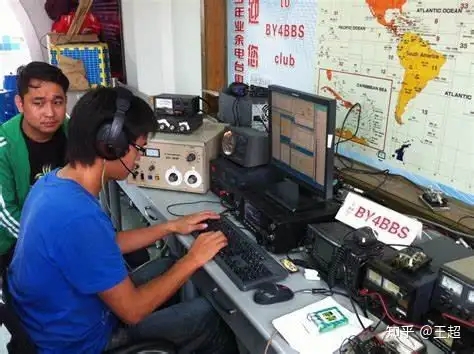
③ DIY amateur radio equipment
With hand-built amateur radio equipment directly connected to a distant friendly station, that will be how proud of the thing, you can start from the assembly of a simple transmitter kit or making antennas, step by step, you can also design their own complex equipment. For our electronic engineers, especially field programmable gate array engineers, you can use FPGA with RF chips to make a software defined radio (SDR), the most popular SDR program is based on the ZYNQ + AD9361 radio architecture.

④ Relay links
Amateur radio repeaters are stations designed to relay amateur radio signals from one location to another. The use of amateur radio repeater networks to extend the communication distance of amateur radio enthusiasts has a centuries-old history. Many countries have long established nationwide amateur repeater networks as a platform for disaster emergency communications. Amateur radio repeaters have played an important role in natural disasters such as the 2008 Wenchuan earthquake in Sichuan Province, the 1991 Hanshin earthquake in Japan and the many forest fires and hurricanes that have struck the United States.
⑤ Emergency relief
Sudden major natural disasters can damage base stations, resulting in communication disruptions that are difficult to restore in a short period of time, and radios can play a very important role at this time.
After the Wenchuan earthquake in Sichuan in 2008, amateur radio enthusiasts in the Sichuan area within a few hours in the degree to the epicenter of the direction of the first line, set up more than a dozen relay stations, become the transportation of the injured and rescue supplies of the traffic command and control of the important communication tools, to pass on very important information.
The Role of Amateur Radio Emergency Communications in the Wenchuan Earthquake https://new.qq.com/rain/a/20210716A08ZSP00 [Note: article not now online]

(vi) Stargazers
The stars in question here are not stars, but spacecraft such as satellites and space stations, through which amateur radio enthusiasts can make remote contacts and speak directly with space station astronauts.
The crew of the International Space Station (ISS) conducts 60-80 special Earth-to-Earth amateur radio passes each year with amateur radio enthusiasts around the globe.
It is not difficult to communicate with astronauts in international space, as long as you have a radio, an antenna, the ISS usually passes overhead every 10 minutes, find an open environment, set the frequency, adjust the angle of the antenna, you can call them, and if you are lucky enough, you will receive a response from the station astronauts.
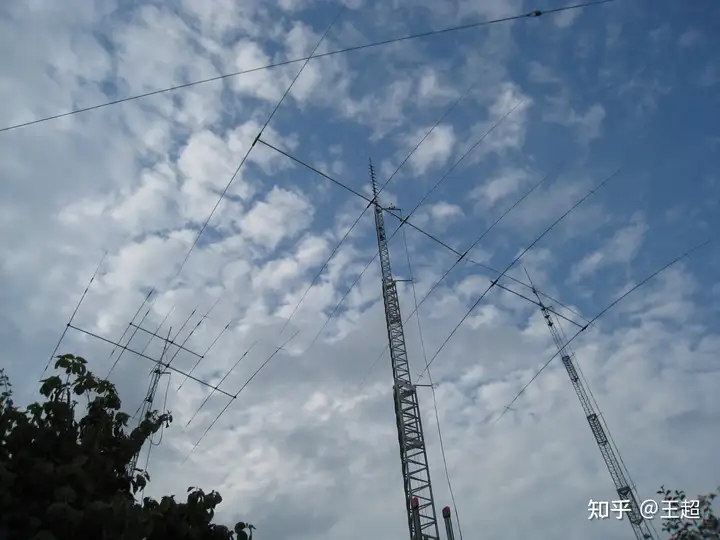
⑦ ATV/SSTV image transmission
Through amateur radio not only audio signals but also images can be transmitted, which is extremely useful in emergency communications. According to the nature of the image can be divided into two categories, and the same as the television transmission of dynamic images called ATV, need to use a wider range of frequency resources, suitable for short-distance or relay communications, transmission of static images called SSTV, only need to take up a small amount of frequency resources, but also in the short-wave band, relying on the ionosphere reflection, the signal transmitted to thousands of kilometers away.
⑧ CW Radio-telegraphic Communication
CW usually refers to telegraph communication, which is one of the oldest forms of radio communication, relying on different combinations of long and short signals, which can transmit letters, numbers and punctuation, and the internationally common signal combination used today is called Morse code.
Amateur radio operators may be confronted with languages from all over the globe, and even if they all speak English or Chinese, they are still plagued by different accents, while CW Morse code does not have this problem, and thus remains popular among amateur radio operators today. More practically, the ability of CW communication to resist jamming is higher than any other communication method. [Translator’s Note: Not really. See Jamming Resistance. End Note]

Amateur radio direction finding
The use of radio direction-finding technology to determine the direction of the radio station, to determine the location of the radio station, is the traditional activities of amateur radio enthusiasts project. A competition for the purpose, commonly known as “radio fox hunting”, that is, the use of hand-held or vehicle-mounted amateur radio direction-finding equipment, on foot or in a car to determine the direction and location of the radio transmitter hidden in advance, than who found the shortest time.
Another to learn the technology and use for the purpose of finding and eliminating sources of interference in the amateur radio frequency band, the problems faced are often more complex, need to learn a more comprehensive radio direction finding technology. It may play a special role in emergency response at unexpected times, such as locating trapped people or other rescue targets used for radio intercom.
6. A festival dedicated to radio enthusiasts – May Fifth
Chinese Amateur Radio Festival (Chinese Amateur Radio Festival), also known as May 5 Festival, is a festival dedicated to amateur radio enthusiasts across the country.
May 5 is a memorable day for amateur radio enthusiasts all over China. It is a holiday created by amateur radio enthusiasts in China with a high degree of patriotic fervor during the War of Resistance Against Japanese Aggression, and it is also the day of the opening of the “China Network (Bravo Net)”, which links the four places on both sides of the Taiwan Strait in China.

In 1937, Japanese invaders provoked the Lugou Bridge Incident [on English language Wikipedia] [Chinese version] [Japanese version on Japanese language Wikipedia] the whole country rose up against the Japanese, the anti-Japanese line was in urgent need of radio communication technicians, some amateur radio enthusiasts went to the anti-Japanese line and organized the establishment of the “Amateur Radio Personnel Wartime Service Corps”.
May 5, 1940, amateur radio enthusiasts around the world through their own amateur radio station held an “on the air” conference to show national unity and perseverance in the anti-Japanese determination, and agreed on May 5 for the “China Amateur Radio Festival”.
Every year, during the May Day, radio associations, radio clubs, and enthusiasts from all over the country organize various commemorative activities.
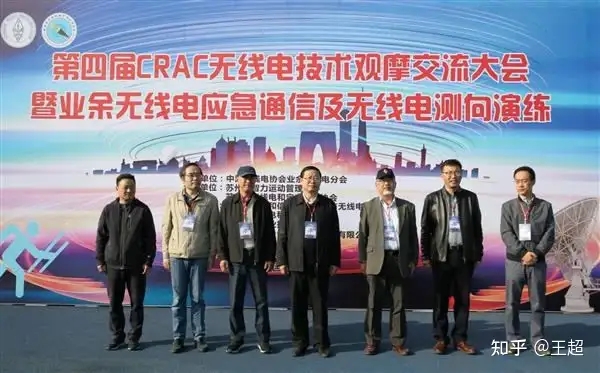
7. Cards Exchanged Between HAMs – QSL cards
“QSL” in the Q-simplified language for communications means “to receive” or “to give a receipt”.
The “QSL” card is a unique amateur radio station credential that confirms contact or listening, so each station should have its own QSL card.
All radio enthusiasts make it their relentless pursuit to get as many cards as possible sent from different countries and regions.
To apply for all amateur radio awards issued internationally, QSL cards are required as proof, and many important international amateur radio contests are also based on the receipt of QSL cards as the basis for evaluating the results, and China has made the receipt of a certain number of QSL cards as one of the necessary conditions for an individual to obtain a higher level [operating certificate].
That’s why every hobbyist is obligated to send their QSL cards in a timely manner.
The size of the QSL card is generally: length 14-15cm, width 9-10cm. for the convenience of mailing, it is better to take the lower limit.

The QSL card must have the station’s call sign printed prominently. In addition to this, the card should include each of the following.
① Station to which the card is sent.
② Confirmation of the contact between the two parties or the report of the listening station, if the listening station card, this item can also not.
③ The year, month, day, hour, and minute of the contact.
③ The year, month, day, hour, and minute of the contact.
④ The frequency to be used for the contact.
⑤ The operation mode used for the contact.
⑥ The signal condition of the other party, i.e., RST report.
7. The location of the station and the detailed address of the QSL card exchange in English and Chinese, and the personal radio station should have the printed symbols in Chinese and Hanyu Pinyin of my family name and first name.
⑧ The name of the unit which set up by the radio station should be the station’s name in English and Chinese.
⑨ Shortwave listener (SWL) card should also be listening listed the worked and called column, in which the WKD the station that was contacted and called the station or area that was called.
⑩ Operator’s signature
The above 10 items are mandatory on the QSL card. If possible, contents such as the station’s equipment, greetings, etc. can also be printed.
The contents of QSL cards are more or less the same in all countries of the world.
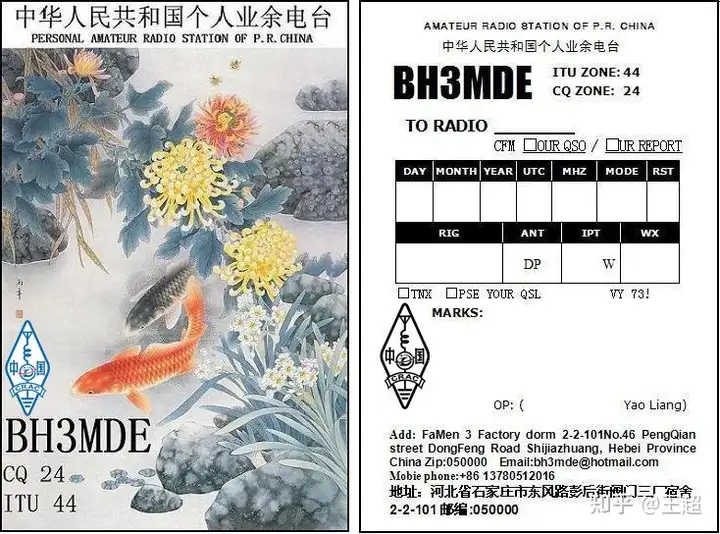
Many enthusiasts also print on the cards pictures that represent their own country or region or other pictures that contain their favorite content, so QSL cards are also a kind of ornamental and collectible artwork.

When HAM friends meet, they often exchange QSL cards and call this “eye ball QSOs”. The cards exchanged should be filled out correctly and there is no point in exchanging blank cards.
The exchange of QSL cards is usually done by direct exchange, through a card authority or a card manager.
① Direct exchange: Cards are sent directly to the mailing address of the contacted party, so the detailed mailing address of the contacted party should be inquired clearly when contacting.
② Exchange through the Card Bureau: Many countries and regions, especially those with a large number of radio stations, have national or local card bureaus (i.e., QSL BUREAU), which are specifically responsible for forwarding QSL cards sent by foreign enthusiasts to amateur radio stations in their own countries, and QSL cards sent by amateur radio stations in their own countries to foreign countries.
At present, there is no official card bureau in China, and some of the QSLs sent by foreign bureaus are relayed through the association radio stations in Beijing, Shanghai and other places, which also organize the centralized mailing of QSL cards to foreign card bureaus on behalf of domestic enthusiasts. Cards sent to domestic stations can be mailed directly.
(iii) Exchanging through a card manager: There are some hobbyists who do not handle their cards directly, but rather through their own card manager (i.e., QSLMANAGER). They send their radio diaries to the card manager at any time, and he or she is responsible for completing the receipt and distribution of cards.
Given the importance of QSL cards in amateur radio activities, the ability to send one’s own QSL card in a timely manner to the contacting party as well as to the listening station that sends the SWL card becomes one of the hallmarks of a station’s reputation.

The kind of radio that only receives and sends out cards or rarely sends out cards is not popular with the hobby. At the same time, if you want to ask for each other (including domestic) card or need each other to reply to the letter, do not forget to put in a SASE, which not only can make oneself faster to receive each other’s return card or reply to the letter, but also is the radio enthusiasts everywhere for the sake of others a virtue.
We should fully recognize these problems to maintain and improve the good reputation of Chinese amateur radio in exchanging QSL cards.
8. Guidelines for amateur radio amateurs
As an amateur radio enthusiast should have the quality of cultivation, technology and other aspects, but the quality of cultivation I think is particularly important:
- Considerate He never intentionally operates in a way that interferes with others.
- Loyal He shows loyalty, encouragement and support to other radio amateurs, local clubs and national associations representing his country.
- Progressive His knowledge keeps pace with scientific developments, so he prides himself on the careful construction of equipment, the use of efficient radios, and attentive operation, and does not lose motivation because of a lack of sophistication.
- Friendly slow and patient sending at the request of the other, friendly guidance and discussion for beginners, kind assistance, cooperation and consideration for the good of others are the hallmarks of amateurism.
- Balanced Radio is a hobby that should not be allowed to interfere with his family, work, studies and social obligations.
- Patriotic Patriotic his radio and skills are always ready to serve his country and society.
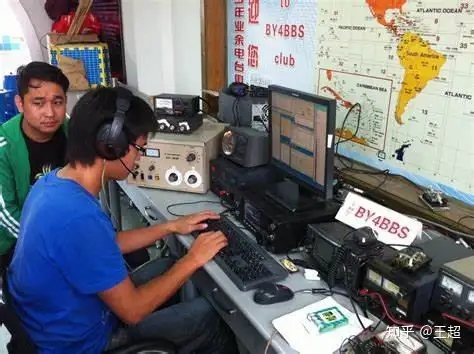
Radio spectrum is a national resource, the use of radio frequency involves communication security, so the setup and use of amateur radio stations must be approved by the radio regulatory agencies, the corresponding amateur radio transmitting activities to receive radio regulatory agencies to supervise and manage, in compliance with laws and regulations.
- No unlicensed or unauthorized launches.
- Frequencies and transmitting power beyond those authorized by the radio administration shall not be used.
- No harmful interference shall be intentionally caused to the normal communications of other operations and other amateur communications.
- When transmitting, you must use the full call sign of your station correctly as specified.
Some times the radio will let you have unexpected gains, such as the famous Baker Street bank robbery, a radio enthusiasts at home at night idly listening to the radio station, the result is heard similar to digging tunnels to the bank vaults of the radio calls, and then the radio enthusiasts calls and alarm and records it. Finally a group of police officers sitting next to the radio station receiver to listen to what is exchanged in the radio, while looking for where bank tunnels were dug through to steal, and finally the case was so broken.
[See the 1971 New York Times story A Radio Ham Tunes in London Police To Tape of $1.2‐Million Bank Robbery
9. Study Materials [Note: Some of these links work from the USA. For a few of those, I replaced with a URL run through Google Translate.]
- VIDEO: How mysterious is a group that represents only 0.01% of the nation’s population – Amateur Radio (https://b23.tv/2pyvL3y )
- Video: Amateur Radio – A Hobby for the 21st Century (https://b23.tv/YGc8nm3 )
- Video: CCTV9 Documentary “Hams・Amateur Radio Amateurs” (https://www.bilibili.com/video/BV1Dh411U7ZP )

- VIDEO: A video teaches you to get your radio license! (https://www.bilibili.com/video/BV1HG4y1j79t )
- VIDEO: Standard Alphabetical Interpretation: Every amateur radio enthusiast should master it. (https://www.bilibili.com/video/BV1Lv411E7i2 )
- The whole process of getting an amateur radio license in Shanghai (https://post.smzdm.com/p/alx7893o/ )
- Amateur Radio Operator’s License Examination Registration Methods and Channels by Provinces (https://www.kechuang.org/t/84164 )
- Operating a ham station in the park, I was taken for a “spy” (https://www.huxiu.com/article/501419.html ).
- Amateur radio practice test practice website (https://www.cqid.cn )
- VIDEO: Radio may save your life when it counts, a true story (https://www.bilibili.com/video/BV1ad4y1m7zF )

10. Summary
The airwaves know no borders; amateurs all over the world use the same radio frequencies, and the vast majority of countries allow amateurs to communicate with each other.
But the behavior of radio enthusiasts is not like fishing, photography or painting, music enthusiasts, so easy to be surrounded by people to understand, amateur radio enthusiasts in the country, has not been widely recognized, amateur radio for most people still belongs to an unfamiliar field.
There is an amateur radio enthusiast, in the park and talked with a foreign by short-wave radio. This was long-distance communication, some shopkeeper, name unknown, thought this was a spy transmitting of information, so called the police. Fortunately, the amateur radio operator’s license and radio station license were with the enthusiast that day, and after careful examination, the police decided that there was nothing improper going on and so closed the case.
From this point of view, it is really difficult for ordinary people to understand what these people who are tinkering with radios and antennas every day are doing. Who are they talking to? What are they talking about? The conversations that they speak in a mixture of Chinese and English, are they talking about some secret stuff?
From the domestic registered number of people, amateur radio enthusiasts still few in number, amateur radio in the means of communication is not so developed today, its effectiveness is also very limited. However when a major natural disaster strikes and communications networks are destroyed, they would be important. Thus is is very practical for China to encourage the general public to join this group, which is, after all, is an emergency force.
Amateur radio has been developing globally for nearly a century, with generation after generation of new technology, and the knowledge is so extensive that it cannot be contained in this article. If you are interested in amateur radio, the best way to get involved is to take the operator’s license, and after applying for a radio license, it is natural to look up the relevant information, buy equipment and learn the knowledge as your financial situation and time and energy allow.
This article is a small contribution to the promotion of amateur radio, and I hope that more fresh forces will join in the future. If by reading this article, you have developed an interest in amateur radio and joined this group, that’s great! If any of our readers have taken the operator’s test and applied for a license, feel free to share your call sign in the public back office and look forward to being on the air one day!
This is BI1OCO.73!
Posted on 2023-01-14 09:28・IP Property Beijing
Beijing Radio Association Bulletin (First Issue 2024)
Published:May 7, 2024
“2024 China HAM ‘May Fifth’ Festival and Beijing Amateur Radio Emergency Communication Exercise”was held in Beijing.
“2024 China HAM ‘May Fifth ‘ Festival and Beijing Amateur Radio Emergency Communication Exercise” was successfully held on May 5 ,2024 at the Shoucheng Community Park, Jinsong Street, Chaoyang District, Beijing.

The event was organized by Beijing Radio Association, undertaken by Beijing Sunny Yutong Technology Development Co., Ltd. and co-organized by Jinsong Street Office of Beijing Chaoyang District Government.
The theme of the event was ”Inherit the fine patriotic tradition of May Fifth’ patriotic fine traditions, improve the level of emergency communication skills”.
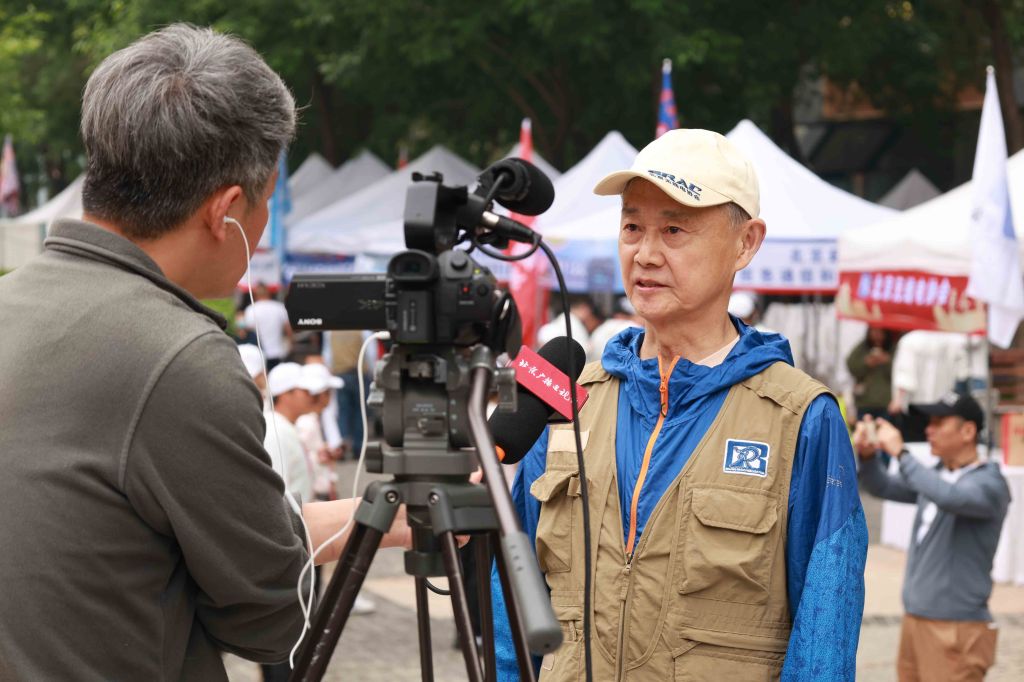
Mao Lei, Director of Radio Safety and Security Department of Beijing Municipal Bureau of Economy and Information Technology,ZhangXiaojun, Deputy Director of Radio Frequency Station Department,WangDongming, Deputy Director of Radio Supervision and Inspection Department , Zhang Yu, Deputy Director of Beijing Radio Monitoring Station, Yu Shaoqing, President of Amateur Radio Branch of Radio Association of China, Lu Gongchao, Former Director of Beijing Radio Administration Bureau, and Feng Weijun, President of Radio Association of Beijing, and other leaders were present.

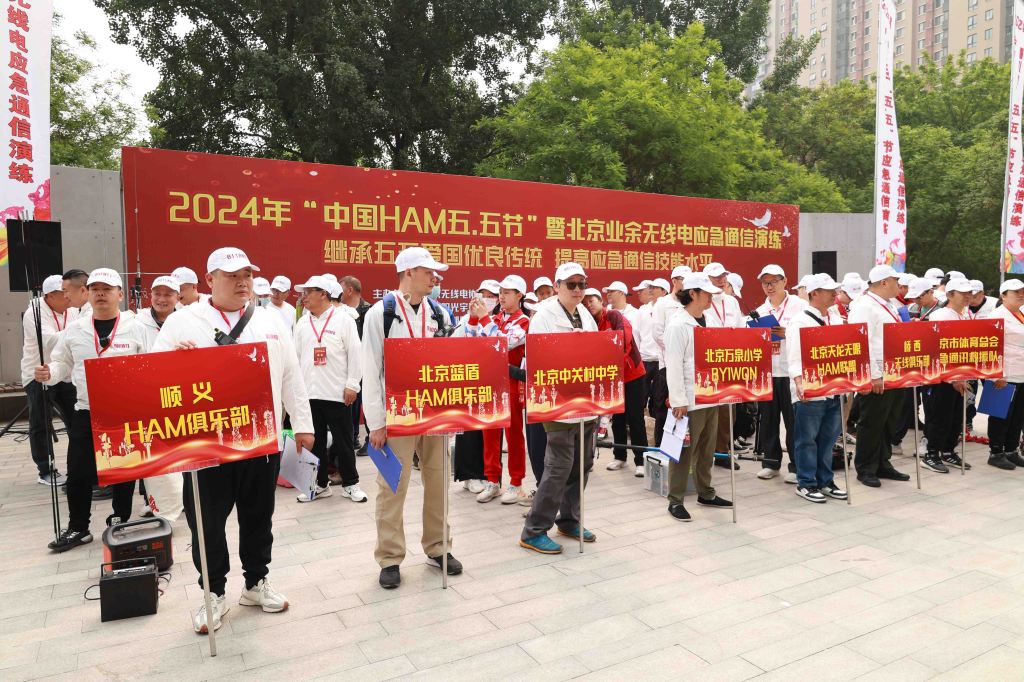
Participating in the emergency communication drill were Huairou District Radio and Orienteering Association, Beijing HAM ‘May Fifth’ Festival Tianlong Unlimited HAM Alliance, Beijing Randon HAM Club, Zhongguancun Middle School, Wanquan Primary School BY1WQN, Qiaoxi Wireless Club, Shunyi HAM Club, Municipal Sports Federation Emergency Communication and Rescue Team, Lvgu Wireless Club, Beijing Sunshine Wireless Club, Beijing University of Posts and Telecommunications BY1BY, Xicheng District Exhibition Road Emergency Communication Team, and 12 other representative teams.
The exercise was led by He Lei, the senior BH1HL.

The opening ceremony began with a speech by Zhang Xiaojun, Deputy Director of the Radio Frequency Station Division of the Municipal Bureau of Economics and Information Technology. On behalf of the Municipal Bureau of Economy and Information Technology, he expressed warm congratulations on the emergency exercise and hoped that the majority of amateur radio enthusiasts would consciously abide by the “Radio Regulations of the People’s Republic of China” and the newly promulgated “Amateur Radio Management Measures“, and through the organization of communication emergency drills and daily skills training and learning exchanges, improve the team and individual business level, and better serve the community.
Yu Shaoqing, President of Radio Association of China Amateur Radio Branch, praised the Beijing Radio Association for its unremitting efforts in organizing the “China HAM ‘May Fifth’ Exchange Fair” in different forms over the past ten years. The president of China Radio Association, Mr. Yu Shaoqing, praised Beijing Radio Association for ten years’ persistence in organizing “China HAM’s ‘5. “HAM representative BA1GM Wang Yufei, on behalf of the majority of amateur radio enthusiasts, said that we will continue to improve the conscientiousness of compliance with the law, continue to improve the business level of emergency communications and rescue, and continue to improve the team’s cohesion and combat effectiveness.
President Feng Weijun of Beijing Radio Association announced the start of the drill. Under the command of Chief Referee Xu Gang, the referee volunteers were responsible for their own duties, organizing the teams to carry out field emergency communication rapid setup, short-wave CW listening and copying, walkie-talkie communication competition, radio direction-finding, remote command and scheduling and other drills in the park venue.



In the closing ceremony the leaders present at the meeting for the teams participating in the exercise were awarded trophies for the winners of various competitions and prizes provided by the sponsoring manufacturers.

In order to cooperate with the “Amateur Radio Management Measures” promulgated by the Ministry of Industry and Information Technology, which came into effect on March 1 this year, especially the promotion and implementation of liberalizing the restriction on minors to set up and use some amateur radio stations, the Association specially organized the Amateur Radio Class A Operation Skill Verification for primary and middle school students in Beijing. From Beijing Chen Jinglun Middle School, Wanquan Primary School, Xicheng District Second Experimental Primary School, BeiJing University Primary School and other schools of 34 primary and secondary school students to participate. Those who were able to pass the skills verification will be the first minors in Beijing to hold a radio license and call sign.
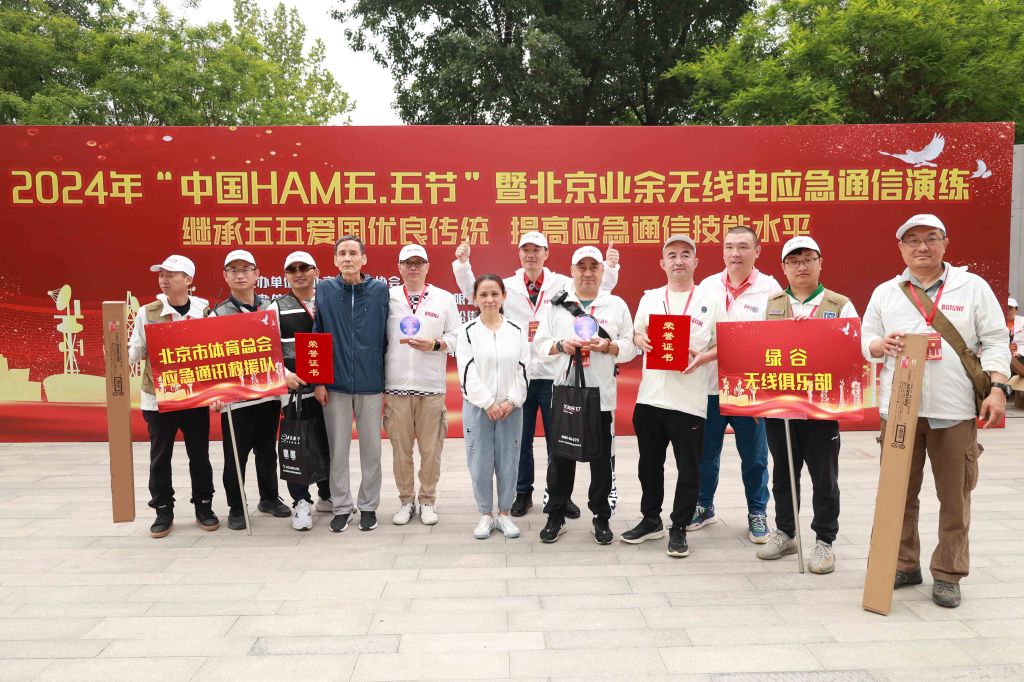
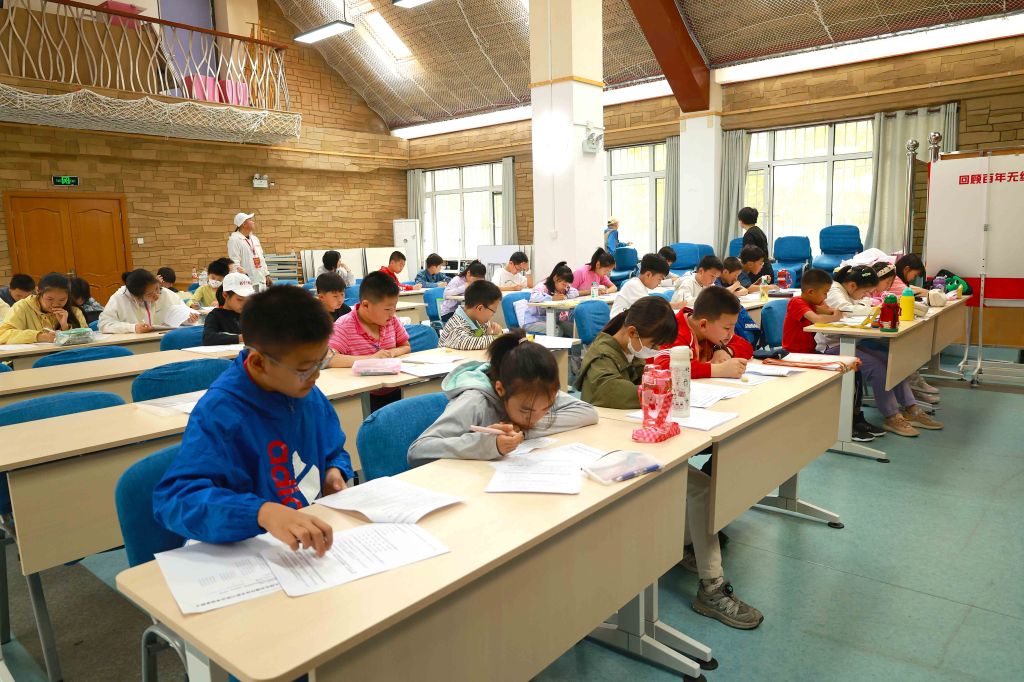
Staff from the Chaoyang District Emergency Rescue Center were on hand to demonstrate emergency assistance methods and coach the public on how to perform artificial respiration and first aid essentials.
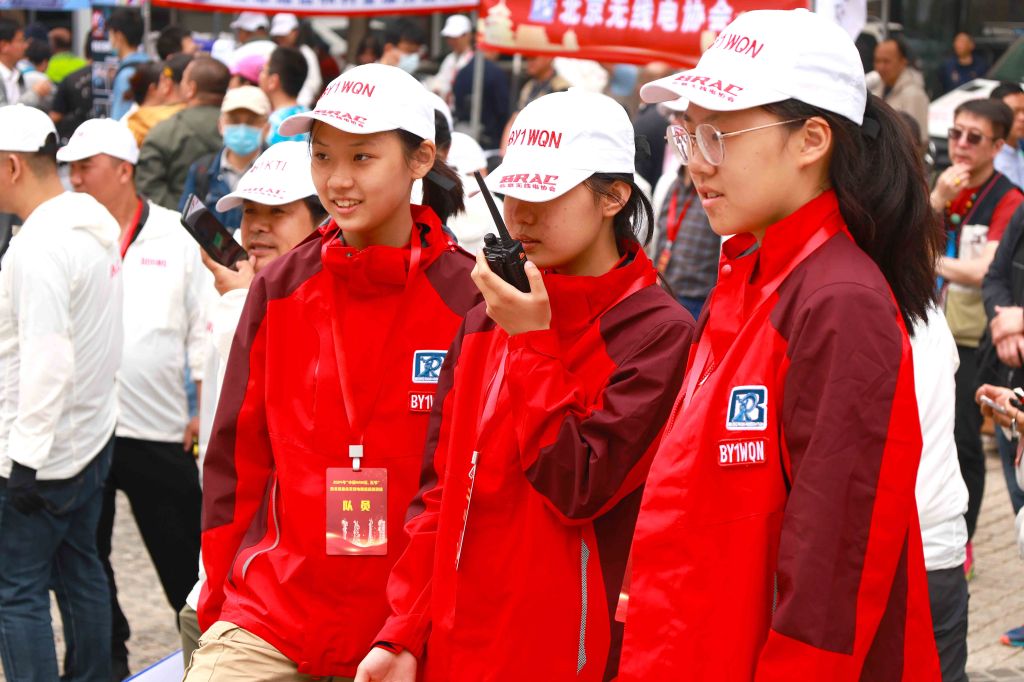
Beijing Century Jinyu, Chongqing Guohe Electronics, Diamond Antenna and other exhibitors displaying the latest amateur radio equipment on site.
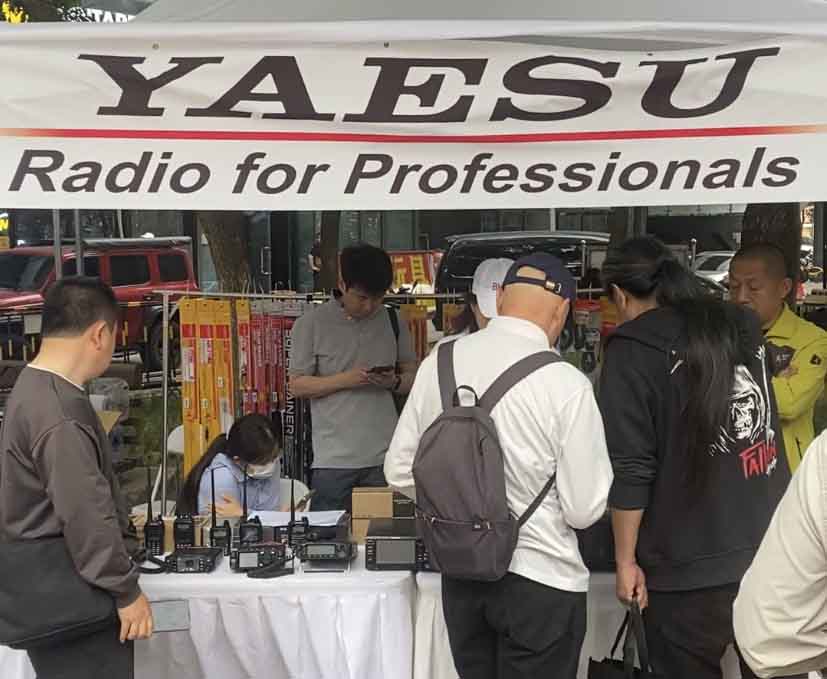

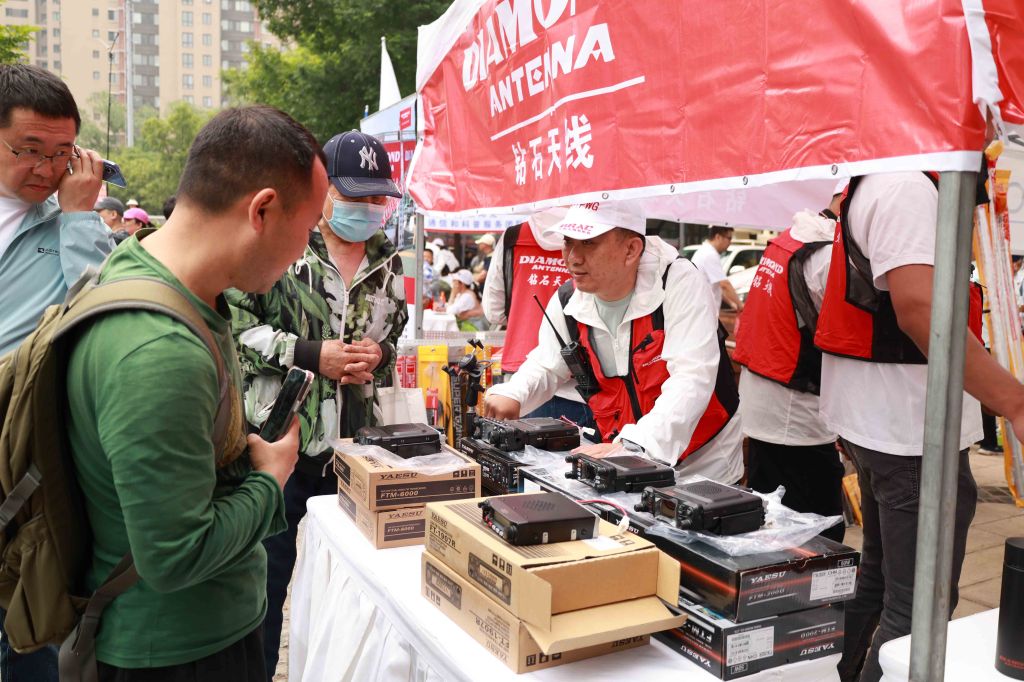
The Amateur Radio teams utilized display boards to present information on their respective activities.
Nearly 400 people from amateur radio enthusiasts in Beijing and people from the Shoucheng community and surrounding areas were present.
Beijing TV, Xinhua, People’s Daily, Beijing Daily, Beijing Youth Daily and other media conducted on-site interviews.
Beijing Radio Association
May 6, 2024

The 2024 May Fifth China Amateur Radio Festival” Commemorative Communication Event was a Success!
2024年度“5.5中国业余无线电节” 纪念通联活动圆满成功
Posted on May 09, 2024
The ” May Fifth China Amateur Radio Festival” organized by the China Radio Amateur’s Club ( CRAC ) has become an important annual event for China’s amateur radio community. During the 2024 Commemorative Communication event held between 0800 GMT on May 3rd and 2000 GMT on May5th Chinese radio amateurs exchanged greetings on the air.
During the event, CRAC set up several stations in 0-9 call area regions of China using BnCRA ( n stands for call area regions 0-9 ) . Other amateur radio stations could score points by contacting these call area main stations and apply for communication certificates for amateur radio enthusiasts to apply for. After selection and license verification, 116 excellent amateur radio enthusiasts from all over the country took up the duty officer work at these main stations during the event to commemorate and celebrate the “May Fifth China Amateur Radio Festival” together with national amateur radio enthusiasts.
As in previous years, the event received enthusiastic response and active participation from amateur radio enthusiasts from all over the world, both at home and abroad. During the 60-hour contact, the modes of communication covered voice, Morse code and data, and some headquarters stations also conducted VHF/UHF telecommunication tests and amateur satellite communication tests. 44,065 radio contacts were made between the main station of the various BnCRA call area stations and amateur stations all over the world including 1,978 unique call signs in China and 6,201 unique call signs abroad. In terms of the modes of communication, there were 7,783 voice contacts, 7,720 Morse code contacts and 28,562 data communications.
Commemorative activities, enthusiasts by trace the history of the “May Fifth China Amateur Radio Festival” to promote the spirit of patriotism, to the community to pass the knowledge of radio science and amateur radio hobby, sharing knowledge, learning from each other, and enhance friendship. During May 1 Chinese national holiday, in addition to commemorating the Day at home, enthusiasts around the world have to carry out outdoor demonstrations and publicity and other forms of activities to celebrate this holiday for “hams” — amateur radio, the century-old amateur hobby.
The China Radio Amateurs Club expresses its gratitude to all the amateurs and volunteers who participated in the organization and implementation of this event, and to all the amateurs who actively participated in the commemorative communication activities of the “May Fifth China Amateur Radio Festival” in 2024.
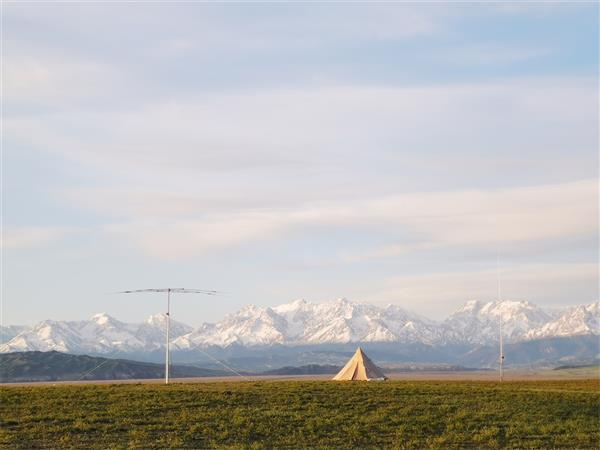



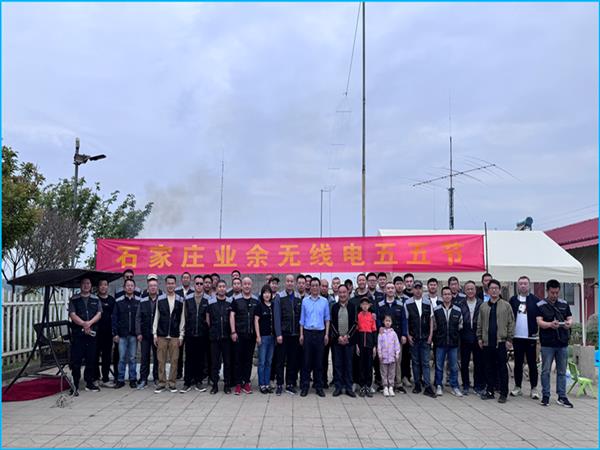
Hebei amateur radio enthusiasts Operate B3CRA and Organize May Fifth Amateur Radio Day Outdoor Awareness Campaign
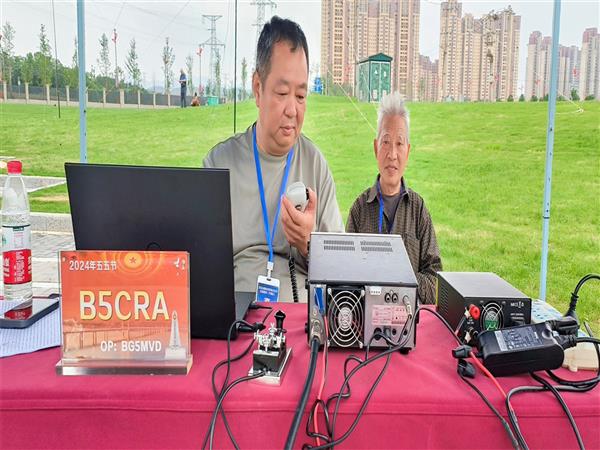
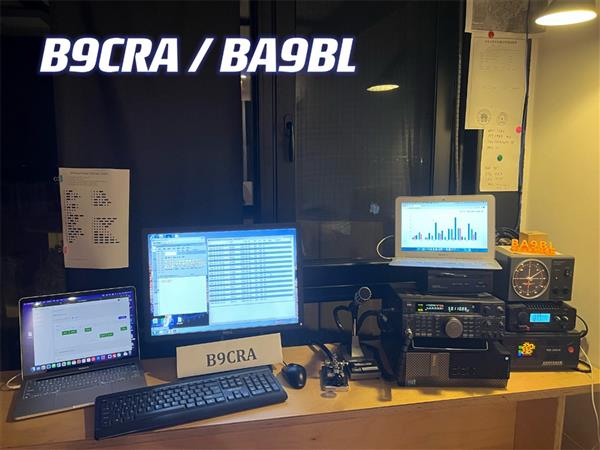

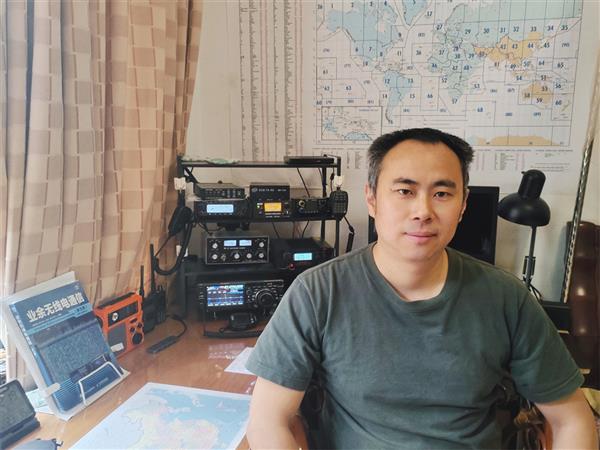
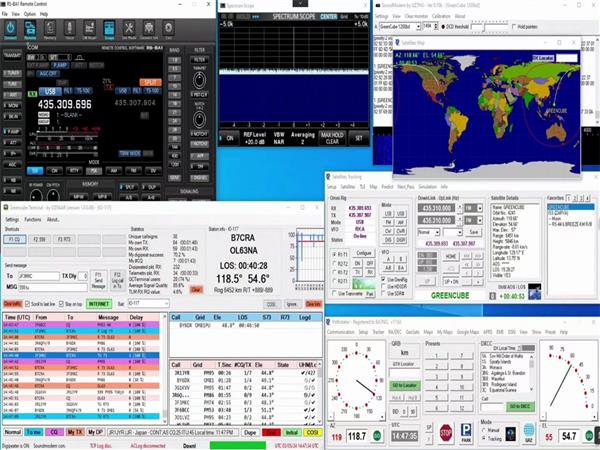
 | |
|---|---|
| 京ICP备10043245号-2 北京市 石景山区实兴大街30号院15栋 E-mail:crac@cr |

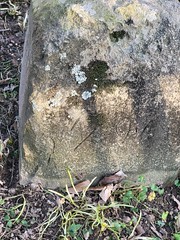

Pingback: Amateur Radio Weekly – Issue 333 • AmateurRadio.com